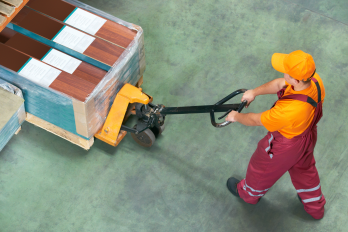- Home ››
- Health and Safety Training ›› Manual Handling
Manual Handling
Introduction to Manual Handling

A major cause of staff absence from the workplace is as a result of incorrect or poor manual handling techniques which lead to ailments such as repetitive strain injury (RSI), muscle pulls and strains, trapped nerves, hernias, work-related upper limb disorders (WRULDs) and one of the most common of all injuries... back problems.
Conditions caused or aggravated by poor manual handling vary not only in their painfulness, but also the time it takes for pain to appear. For example, a muscle tear will be felt immediately, whereas other conditions may take a certain amount of time before pain occurs, like repetitive strain injury where a worker can perform a task quite happily for a while before they experience any problems (hence the word 'repetitive' in the name).
Along with the time taken for symptoms to appear, different manual handling injuries take different lengths of time to heal, although it will depend on the level of damage done in the original incident and the amount of time it is given to heal. At one end of the spectrum, a minor muscle pull will heal completely within a few days or so if given complete rest, whereas a dislocation or hernia will take much longer. For some, their injuries may never fully heal, such as a back injury which troubles a person for the rest of their life. This is why it is essential that manual handling injuries, or rather the prevention of them, is not overlooked and is given serious attention when compiling or conducting your company's health and safety training programme.
How to reduce the risk of manual handling injuries occuring

To reduce the risks of manual handling injuries occurring, there are a number of steps that can be taken. As mentioned above, suitable manual handling training will give workers and employees the knowledge to utilise correct manual handling techniques when moving loads in the workplace through lifting, pulling, carrying, pushing etc. Although many people may already believe they know how to lift or move an object, they may not know how to do it correctly and minimise the chances of an injury to themselves.
The Manual Handling Operations Regulations 2019, as well as The Management of Health and Safety at Work Regulations, mean employers have a legal duty and responsibility to ensure that sufficient manual handling risk assessments are performed for manual handling activities so that injuries can be avoided.
The results of a manual handling risk assessment may highlight the need for things such as additional or more comprehensive health and safety training, the provision of machinery and equipment to assist with the lifting or moving of a load, re-arranging the workspace so that loads do not need to be moved over as great a distance, splitting the load into separate smaller ones if this is practical etc.
One of the most common reasons for a worker suffering a manual handling injury is when they try and manipulate a load which is beyond their physical capabilities. Whether it is too heavy, awkward, unstable, or a combination of these or other reasons, it can often result in over-stressing their body and bringing about an injury such as a slipped disc or muscle tear which has the potential to keep them away from the workplace for a lengthy period of time. This is not only inconvenient from an employer's point of view in terms of the organisational and administrative headaches that ensue, but will also have a financial impact in terms of lost output and sick pay.
It is important that employers do not allocate a worker a task that requires a physical exertion which is beyond their capabilities. For example, it is inappropriate to expect a worker who is more advanced in age to do heavy lifting or extremely tiring work, as they are much more likely to be more susceptible to suffering a manual handling injury than a younger person would be.
Why is Manual Handling Training Needed?

Manual handling regulations place a duty on employers to safeguard their employees as much as is reasonably practical against injuries caused by the handling of items and objects during their work activities.
As with personal protective equipment, the first step is to try to avoid the risk altogether by either redesigning the task so that the load does not need to be moved at all or, if it does need to be moved, introducing mechanical apparatus which eliminates the need for a person to use their own strength to move it.
If avoidance is not a viable option, then the employer should perform a manual handling risk assessment which identifies the potential risks and hazards that the worker could encounter, as well as dealing with a number of important questions such as the distances that the load needs to be moved, the size of the load, the stability of the contents and the amount of rest periods between movement of the same or other items/objects.
Along with the control measures which come about as a result of the risk assessment, manual handling training will also play a big part in reducing the number of manual handling-related injuries, and the subsequent time off work which occurs as a result. Training will teach workers the types of injuries that can occur through incorrect manual handling, the correct manual handling techniques along with how to use provided aids such as lifting machinery.
Real World Manual Handling Advice

"You don't really understand the full importance of employee safety until you've spent three years working for a law firm. Every single lift job, every single time, I was asked if I thought I could handle the job. Extensive tools were provided to make all the manual labour easier and the extent of the safety precautions taken was mind boggling. After one minor incident, I've never been so looked after in my life; it was a full week before they'd let me carry anything again for fear of injury."
About one-third of work-related injuries are musculoskeletal disorders (MSDs) which are usually caused by incorrect manual handling techniques. One of the most common reasons employees take time off from work to recover from injury is sprained, strained, or torn muscles as a result of manual lifting. It doesn't matter whether you run a law firm, care home or a farm, manual handling is something most of your employees will encounter. If you aren't prepared, there are serious risks and consequences involved for both the individual and the business. So, how do you prepare?
1. Minimise the need for manual handling. Eliminating the hazard is the first step to take for any health and safety if it is reasonably practical to do so. Obviously, this is a lot easier in an office than a construction site and either way completely eliminating the need is virtually impossible. Still, when planning a project that will involve heavy lifting, always begin by asking the questions, "Is this completely necessary? Is there any part of this project that can be eliminated?"
2. Use tools to minimise the risk of manual handling. Don't let an employee lift what a dolly can easily handle. Machines carry risks as well, so be wary of these when considering what tools to invest in, but always be sure you are utilising the tools available to their full extent.
3. Dialogue with your employees. The obvious application is asking an employee what they can easily handle, but dialogue often includes asking an employee if they see any risks that you haven't noticed or if they can see an easier way of accomplishing a specific goal. Always be aware that many people will not want to admit that the load is too much for them, so some judgment on your part may be needed to stop them taking on something which may injure them.
4. Train your employees. This is the big one. You have a responsibility to your employees to watch out for their safety and provide manual handling training, whilst employees also have some responsibility for looking after themselves. Training your workforce regularly in the safest way to accomplish manual handling is the best way to avoid such an injury in the workplace.
Sprains, tears, and back pain don't have to be a peril in your workplace. By doing your research on how to have a safe environment for your employees you can minimise the risk of injuries, protecting your business and your employees in the process.
Manual Handling Training for Young People
When it comes to manual handling, like many other health and safety dangers, young people are often amongst the most at risk of accidents and injuries. There are a number of reasons for this.
One is inexperience. Young people joining as apprentices or coming straight out of school or college may never have experienced an injury caused by incorrect manual handling techniques, so will be largely unaware of the pain or recovery time needed after suffering a manual handling injury that prevents them from carrying out their work duties. Making new starters attend manual handling training courses will give them the knowledge required to perform manual handling tasks correctly and so reduce the chances of injury.
The other reason young people are most at risk is a tendency to show off and try to impress those around them. Whilst this can be true for a person of any age, most often than not it is a young person trying to put on a show of strength by lifting a weight which is too heavy, or thinking that using equipment to help with the load is for the weak. This may also be due to a lack of experience in not knowing how heavy the load can be when it is moved over a distance, but, whatever the reason, trying to lift or move a load beyond a person's capabilities is one of the primary causes of manual handling injuries.
As well as injuries such as dislocations and muscle pulls, the load itself may also pose a danger to the person and those around, such as a coshh risk if it is a hazardous substance.
Even though young people are at risk of manual handling injuries because of the reasons mentioned above, all workers are at risk, and everyone should be given sufficient health and safety training which includes a manual handling course.
Related Manual Handling Pages/Articles
- The Dangers of Manual Handling
- The Load
- Manual Handling Responsibilities
- Manual Handling and Advanced Materials
- Manual Handling - Stand Rather Than Sit?
- The Importance of Safe Lifting
- Manual Handling During Demolition


